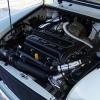From: Marcel Chichak
Subject: adjustable oil pressure relief valve
Mini power plants suffer from an inherent design flaw: there's inadequate protection against metal shavings from the gearbox getting into the engine. The usual result is scratched oil pump components, damaged crank and cam bearing surfaces and, at worst, scored crank journals. One other thing that happens is that shavings get into the oil pressure relief valve, which can cause it to seize against the seat (oil pressure >>100 PSI) or off the seat (0-20 PSI max).
A couple of things have been tried to avoid this problem, one of which is inserting a magnet in the back of the gearbox near the oil pick-up pipe. I don't like these since the shavings are being collected in a very small space directly in the high velocity oil flow so when enough junk is collected it gets swept off the magnet straight into the oil pump... in one large mass. Better off not to have it at all. Next time I do a gearbox I'll be gluing (Locktite or epoxy) several rare-earth magnets to the bottom of the sump a little in front of, but parallel to, the oil pick-up. This will keep the shavings firmly nailed down in a low velocity area and out of harm's way. Of course it will be a pain in the patoot to remove the shavings at rebuild time, but better that than grinding the crank and flushing the galleries.
The problem with the design of the pressure relief valve is that the valve plunger is a cylinder which is tightly confined along its length. One small shaving is all that's needed to cause problems. All that's really required is enough of a valve to seal against the seat. To address this, some bright bulb figured out that a ball bearing can replace the plunger and get around all the problems. Here's how it's done:
Remove the oil pressure relief valve dome nut (1" wrench), remove the pressure spring. Insert a finger into the hole (turn your head and cough, sir) and extract the plunger. Drill and tap a 5/16" UNF thread in the centre of the dome nut, thread a nut onto a 2" bolt and screw it into the dome nut. Cut 3 coils off the pressure spring and roll the last coil over to make a nice square bearing area. To be able to use the bolt as an adjuster, you'll need to ensure the spring bears upon it properly. This can be accomplished by either rooting around until you find an appropriate washer, or make up a thin steel disk which just fits inside the diameter of the dome nut. Obtain a 1/2" diameter ball bearing. CV joints are a good source for these, or go to a bearing supply shop who will likely just give you one since it's not worth their while to write it up.
Now, you're all set. Insert the ball bearing, then the spring and capture it all with the dome nut. Screw the adjuster all the way out and start the engine. Watch the pressure gauge closely: if it reads:
>60 PSI, shut the engine down and take another coil off the spring; ~55 PSI, close enough, you've earned your brew; <50 but >20 psi, go to the engine and screw in the bolt until the gauge reads 50 PSI; <20 PSI, you've buggered a spring and you need to find another one!
Mine ended up needing 4 coils cut off, but I started with 3. Once you've set the pressure you want, I recommend 50 PSI, set the lock nut.
An interesting thing about this setup is that the oil pressure stays at 50 PSI. Cold starts with thick oil: 50 PSI. Hot starts with thin oil: 50 PSI. Highway running at 90 MPH: 50 PSI. Hot idling: 50 PSI.
the last thing with the screw sounds interesting



















